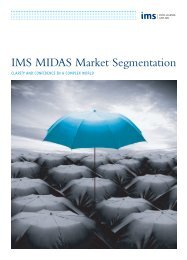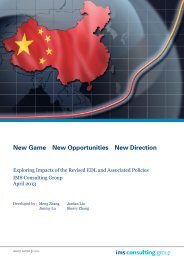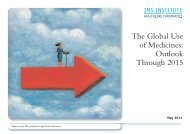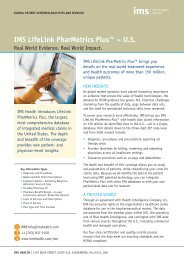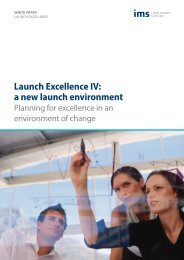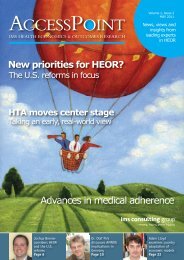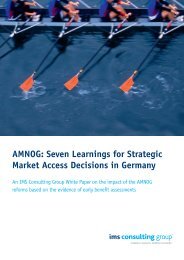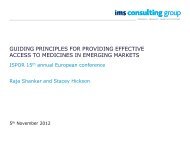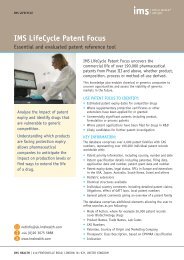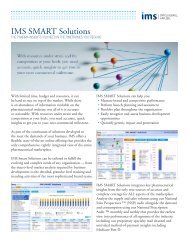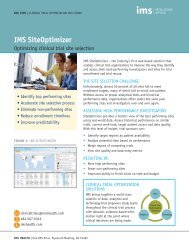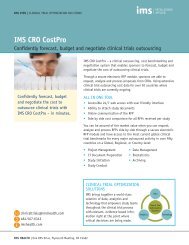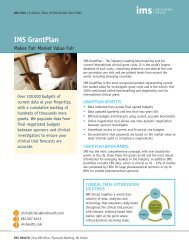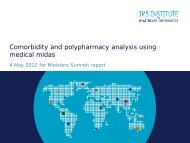Securing IP and Access to Medicine: Is Oncology the Next HIV?
Securing IP and Access to Medicine: Is Oncology the Next HIV?
Securing IP and Access to Medicine: Is Oncology the Next HIV?
You also want an ePaper? Increase the reach of your titles
YUMPU automatically turns print PDFs into web optimized ePapers that Google loves.
<strong>Securing</strong> <strong>IP</strong> <strong>and</strong> <strong>Access</strong> <strong>to</strong> <strong>Medicine</strong>:<br />
<strong>Is</strong> <strong>Oncology</strong> <strong>the</strong> <strong>Next</strong> <strong>HIV</strong>?<br />
An IMS Consulting Group White Paper on compulsory licensing <strong>and</strong> o<strong>the</strong>r<br />
risks <strong>to</strong> intellectual property rights in oncology<br />
TM
Table 1 Timeline of compulsory licenses, threats <strong>and</strong> <strong>IP</strong> losses since 2001<br />
Year Market TA Products Outcome<br />
2001 Brazil <strong>HIV</strong>/AIDS<br />
S<strong>to</strong>crin, Viracept,<br />
Crixavan<br />
Discount<br />
2001-2003 South Africa <strong>HIV</strong>/AIDS 8 ARVs VL/Discount/None<br />
2002 Egypt ED Viagra CL<br />
2004 Malaysia <strong>HIV</strong>/AIDS<br />
Videx, Retrovir,<br />
Combivir<br />
2002-2003 Zimbabwe <strong>HIV</strong>/AIDS All ARVs CL<br />
2004 Mozambique <strong>HIV</strong>/AIDS Epivir, Viramune, Zerit CL<br />
2004 Zambia <strong>HIV</strong>/AIDS Epivir, Zerit, Viramune CL<br />
2005 Argentina P<strong>and</strong>emic Flu Tamiflu VL<br />
2005 Brazil <strong>HIV</strong>/AIDS Kaletra, Viread Discount<br />
2005 Ghana <strong>HIV</strong>/AIDS All ARVs CL<br />
2004 Indonesia <strong>HIV</strong>/AIDS Epivir, Viramune CL<br />
2005 Taiwan P<strong>and</strong>emic Flu Tamiflu CL<br />
2005 China P<strong>and</strong>emic Flu Tamiflu VL<br />
2005 Korea P<strong>and</strong>emic Flu Tamiflu CL<br />
2006 India <strong>Oncology</strong> Glivec Patent rejected<br />
2006-2007 Thail<strong>and</strong> <strong>HIV</strong>/AIDS S<strong>to</strong>crin, Kaletra CL<br />
2007 Brazil <strong>HIV</strong>/AIDS S<strong>to</strong>crin CL<br />
2007 Thail<strong>and</strong> CVD Plavix CL<br />
2007 Canada/Rw<strong>and</strong>a <strong>HIV</strong>/AIDS Apo-TriAvir CL<br />
2007-2008 Thail<strong>and</strong> <strong>Oncology</strong> Glivec Discount<br />
2007-2008 Thail<strong>and</strong> <strong>Oncology</strong><br />
Taxotere, Femara,<br />
Tarceva<br />
2010 Ecuador <strong>HIV</strong>/AIDS Kaletra CL<br />
2010 India <strong>HIV</strong>/AIDS Valcyte Patent revocation<br />
2012 India <strong>Oncology</strong> Nexavar CL<br />
2012 India HCV/HBV Pegasys Patent revocation<br />
2012 India <strong>Oncology</strong> Sutent Patent revocation<br />
2012 India <strong>Oncology</strong> Tarceva Ruling allows generic<br />
2012 Ecuador <strong>HIV</strong>/AIDS Kivexa CL<br />
2012 Indonesia <strong>HIV</strong>/HBV 7 ARVs CL<br />
2013 India <strong>Oncology</strong><br />
Herceptin, Sprycel,<br />
Ixempra<br />
Sources: http://www.plosmedicine.org/article/info%3Adoi%2F10.1371%2Fjournal.pmed.1001154; http://www.keionline.org/<br />
misc-docs/recent_cls_8mar07.pdf; http://www.scidev.net/en/health/news/ecuador-issues-compulsory-license-for-drug-againsthiv.html?utm_source=link&utm_medium=rss&utm_campaign=en_health;<br />
http://articles.economictimes.indiatimes.com/2010-<br />
05-06/news/28394772_1_patent-office-valcyte-patent-grants; http://www.pmlive.com/pharma_news/roche_loses_indian_tarceva_patent_battle_with_cipla_424903;<br />
http://www.swissinfo.ch/eng/business/Novartis_awaits_cancer_drug_ruling_in_India.<br />
html?cid=32197530<br />
CL<br />
CL<br />
CL initiated<br />
2<br />
Copyright © IMS Consulting Group 2013
TM<br />
<strong>Securing</strong> <strong>IP</strong> <strong>and</strong> <strong>Access</strong> <strong>to</strong> <strong>Medicine</strong>:<br />
<strong>Is</strong> <strong>Oncology</strong> <strong>the</strong> <strong>Next</strong> <strong>HIV</strong>?<br />
Developed countries were plagued by a growing epidemic with high mortality, as curative<br />
treatments had yet <strong>to</strong> be developed. Pharmaceutical manufacturers responded by investing<br />
in effective treatments, which helped <strong>to</strong> quell <strong>the</strong> epidemic. However, incidence <strong>and</strong><br />
mortality in developing countries continued <strong>to</strong> rise, until <strong>the</strong> disease became one of<br />
<strong>the</strong>ir biggest killers. Most patients could not get <strong>the</strong> new treatments as <strong>the</strong>y could not<br />
afford <strong>the</strong>ir cost. These countries were forced <strong>to</strong> find new ways <strong>to</strong> provide access <strong>to</strong> lifesaving<br />
or life-prolonging <strong>the</strong>rapies. Attempts by governments <strong>to</strong> cut prices were resisted<br />
by manufacturers, who had invested significantly in development. Manufacturers were<br />
concerned with maintaining <strong>the</strong> incentive for future innovation <strong>and</strong> protecting <strong>the</strong>ir prices<br />
in developed countries.<br />
When developing countries could not reach agreement<br />
with manufacturers on prices, several resorted <strong>to</strong><br />
compulsory licensing. Generic manufacturers were keen<br />
<strong>to</strong> take on <strong>the</strong>se licenses as <strong>the</strong>y could make a profit<br />
without investing in R&D. Civil society organizations<br />
such as Médecins Sans Frontières (MSF) <strong>and</strong> patient<br />
associations also welcomed <strong>the</strong> breaking of patents <strong>to</strong><br />
provide broader access. Generic manufacturers <strong>and</strong> civil<br />
society organizations even collaborated <strong>to</strong> advocate for<br />
compulsory licenses.<br />
Pharmaceutical manufacturers responded in two ways.<br />
First, <strong>the</strong>y engaged with developed country governments<br />
<strong>to</strong> convince developing country governments <strong>to</strong> reverse<br />
compulsory licenses <strong>and</strong> protect <strong>the</strong>ir intellectual<br />
property. Second, <strong>the</strong>y argued that healthcare financing,<br />
infrastructure <strong>and</strong> market imperfections, such as<br />
doc<strong>to</strong>rs <strong>and</strong> hospitals selling medicines <strong>to</strong> patients<br />
<strong>and</strong> not passing on manufacturer discounts, were more<br />
important barriers <strong>to</strong> access than price.<br />
Nei<strong>the</strong>r of <strong>the</strong>se responses was successful. Afraid of <strong>the</strong><br />
public backlash from Non-Governmental Organizations<br />
(NGOs) <strong>and</strong> unwilling <strong>to</strong> be seen as supporting denial<br />
of access <strong>to</strong> life-saving or life-prolonging treatments,<br />
developed country governments offered only tepid<br />
support. Developing countries acknowledged <strong>the</strong> o<strong>the</strong>r<br />
barriers but did not agree that <strong>the</strong>se needed <strong>to</strong> be<br />
fixed before addressing prices. They <strong>the</strong>refore issued<br />
compulsory licenses or used compulsory licensing as a<br />
threat <strong>to</strong> obtain lower prices.<br />
Pharmaceutical companies were faced with <strong>the</strong><br />
choice of ei<strong>the</strong>r forgoing <strong>the</strong>ir intellectual property<br />
rights or collaborating with governments <strong>and</strong> third<br />
party organizations <strong>to</strong> provide broader access. Many<br />
companies decided <strong>to</strong> address <strong>the</strong> problem of access<br />
by following a set of strategies – differential pricing<br />
across countries, tiered pricing within countries,<br />
patient assistance programs, voluntary licensing <strong>to</strong><br />
lower cost manufacturers, <strong>and</strong> partnerships with<br />
governments <strong>and</strong> international organizations – <strong>to</strong><br />
tackle both <strong>the</strong> affordability issue <strong>and</strong> o<strong>the</strong>r barriers<br />
such as infrastructure, technology, awareness <strong>and</strong><br />
education. This resulted in broader access <strong>and</strong> was<br />
Copyright © IMS Consulting Group 2013<br />
3
successful in bringing down incidence <strong>and</strong> prevalence<br />
in many developing countries, while reducing fur<strong>the</strong>r<br />
infringements of intellectual property.<br />
Most readers will recognize this as <strong>the</strong> s<strong>to</strong>ry of <strong>HIV</strong>/<br />
AIDS. But drawing on <strong>the</strong> parallels between burden<br />
of disease, emotional impact <strong>and</strong> lack of access in<br />
developing markets, <strong>HIV</strong>/AIDS could potentially<br />
be replaced with cancer <strong>and</strong> <strong>the</strong> s<strong>to</strong>ry would read<br />
comparably, except for <strong>the</strong> final piece: governments,<br />
manufacturers, <strong>and</strong> third party organizations have not<br />
yet found an access solution that protects intellectual<br />
property.<br />
This paper looks at how compulsory licensing <strong>and</strong><br />
o<strong>the</strong>r forms of patent denials are spreading beyond<br />
<strong>HIV</strong>/AIDS. It argues that while this has so far been<br />
limited <strong>to</strong> a h<strong>and</strong>ful of countries, <strong>the</strong>re is a real<br />
possibility that patents will come under greater<br />
pressure, especially in oncology, which is becoming<br />
one of <strong>the</strong> leading causes of mortality in developing<br />
countries. The paper concludes with a discussion about<br />
possible solutions.<br />
Compulsory licensing <strong>and</strong> patent<br />
infringements are spreading beyond<br />
<strong>HIV</strong>/AIDS<br />
Subsequent <strong>to</strong> <strong>the</strong> Doha Declaration in 2001 (see Box<br />
1), several countries used compulsory licensing, or <strong>the</strong><br />
threat <strong>to</strong> use it, <strong>to</strong> increase access <strong>to</strong> <strong>HIV</strong>/AIDS drugs<br />
at more affordable prices. Brazil used <strong>the</strong> threat of<br />
compulsory licensing <strong>to</strong> obtain discounts for drugs such<br />
as S<strong>to</strong>crin, Viracept, <strong>and</strong> Crixavan. This was followed by<br />
developing countries in Asia, Latin America, <strong>and</strong> Africa<br />
using compulsory licenses or threats <strong>to</strong> obtain cheaper<br />
access <strong>to</strong> anti-retroviral drugs (see Figure 1 <strong>and</strong> Table<br />
1). Until <strong>the</strong> middle of <strong>the</strong> last decade, <strong>the</strong> use or<br />
threat of compulsory licensing was largely limited<br />
<strong>to</strong> <strong>HIV</strong>/AIDS. The only exceptions were temporary<br />
compulsory licenses for flu epidemics in China, Taiwan,<br />
Korea, <strong>and</strong> Argentina, <strong>and</strong> a one-off compulsory license<br />
for Viagra in Egypt.<br />
Compulsory licensing started spreading <strong>to</strong> o<strong>the</strong>r<br />
<strong>the</strong>rapy areas outside of <strong>HIV</strong>/AIDS <strong>and</strong> p<strong>and</strong>emic<br />
flu beginning in 2007, when Thail<strong>and</strong> authorized a<br />
Figure 1 The spread of compulsory licensing <strong>and</strong> <strong>IP</strong> infringement beyond <strong>HIV</strong>/AIDS<br />
2005<br />
Tamiflu compulsory<br />
licensed in Taiwan,<br />
Korea<br />
2006<br />
Glivec<br />
patent<br />
rejected in<br />
India<br />
2007 - 2008<br />
Femara, Tarceva & Taxotere<br />
compulsory licensed<br />
in Thail<strong>and</strong><br />
Mar. 2012<br />
Nexavar<br />
compulsory<br />
licensed in<br />
India<br />
Nov. 2012<br />
Kivexa<br />
compulsory<br />
licensed<br />
in Ecuador<br />
1994 2000 2001 2002 2003 2004 2005 2006 2007 2008 2009 2010 2011 2012 2013<br />
Apr. 1994<br />
TR<strong>IP</strong>S<br />
agreement<br />
Signed Nov. 2001<br />
Doha declaration<br />
signed<br />
2002<br />
Viagra<br />
compulsory<br />
licensed in Egypt<br />
2002 - 2010<br />
Combivir, Epivir, Kaletra, S<strong>to</strong>crin &<br />
Viramune compulsory licensed<br />
across Latin America, Africa<br />
<strong>and</strong> SE Asia<br />
2007<br />
Plavix<br />
compulsory<br />
licensed in Thail<strong>and</strong><br />
2010<br />
Valcyte<br />
patent<br />
revoked in<br />
India<br />
Sept. - Nov. 2012<br />
Pegasys & Sutent<br />
patents revoked<br />
<strong>and</strong> ruling allowing<br />
Tarceva generic in<br />
India<br />
Oct. 2012<br />
Atripla, Kaletra, S<strong>to</strong>crin,<br />
Truvada, Videx, Viread & Ziagen<br />
compulsory licensed<br />
in Indonesia<br />
Jan. 2013<br />
Process<br />
started <strong>to</strong><br />
compulsory<br />
license<br />
Herceptin,<br />
Sprycel &<br />
Ixempra in<br />
India<br />
KEY: <strong>Oncology</strong> <strong>HIV</strong>/AIDS O<strong>the</strong>r TAs<br />
Sources: See Table 1<br />
4<br />
Copyright © IMS Consulting Group 2013
TM<br />
Box 1: What is compulsory licensing <strong>and</strong> is it legal?<br />
In April 1994, members of <strong>the</strong> World Trade Organization (WTO) signed <strong>the</strong> Agreement on Trade Related<br />
Aspects of Intellectual Property Rights (TR<strong>IP</strong>S), which permits compulsory licensing in <strong>the</strong> case of national<br />
emergencies. In 2001, <strong>the</strong> World Health Organization (WHO) signed <strong>the</strong> Doha Declaration, emphasizing <strong>the</strong><br />
importance of interpreting <strong>the</strong> TR<strong>IP</strong>S Agreement in a way that supports public health. The Doha Declaration<br />
provides WHO members with <strong>the</strong> freedom <strong>to</strong> determine grounds for implementing compulsory licenses<br />
<strong>and</strong> affirms that public health crises such as <strong>HIV</strong>/AIDS, tuberculosis, malaria, <strong>and</strong> o<strong>the</strong>r epidemics, can<br />
represent a national emergency.<br />
Sources: http://www.w<strong>to</strong>.org/english/tra<strong>to</strong>p_e/trips_e/intel2_e.htm<br />
http://www.w<strong>to</strong>.org/english/<strong>the</strong>w<strong>to</strong>_e/minist_e/min01_e/mindecl_trips_e.htm<br />
compulsory license for Plavix, citing <strong>the</strong> importance<br />
of <strong>the</strong> <strong>the</strong>rapy <strong>and</strong> <strong>the</strong> government’s inability <strong>to</strong> cover<br />
<strong>the</strong> cost of <strong>the</strong> br<strong>and</strong>ed drug. While this first non-<strong>HIV</strong>/<br />
AIDS or p<strong>and</strong>emic flu compulsory license was for a<br />
cardiovascular drug, recent compulsory licenses have<br />
mainly been in oncology. In 2007-2008, Thail<strong>and</strong><br />
issued compulsory licenses for Tarceva, Femara, <strong>and</strong><br />
Taxotere, stressing <strong>the</strong> high prevalence of lung <strong>and</strong><br />
breast cancer in Thail<strong>and</strong> <strong>and</strong> <strong>the</strong> inaccessibility of<br />
adequate treatment. This has been followed by <strong>the</strong><br />
granting of a compulsory license for Nexavar in India<br />
in 2012, <strong>and</strong> <strong>the</strong> initiation of a process for compulsory<br />
licensing Herceptin, Sprycel, <strong>and</strong> Ixempra in 2013.<br />
These decisions demonstrate how countries interpret<br />
<strong>the</strong> Doha Declaration in determining what constitutes a<br />
public health emergency. It is not just about ensuring<br />
adequate supply of treatment in a p<strong>and</strong>emic situation;<br />
lack of access due <strong>to</strong> affordability has also become a<br />
fac<strong>to</strong>r in determining when compulsory licenses can be<br />
issued.<br />
Compulsory licenses are not <strong>the</strong> only form of post-<br />
TR<strong>IP</strong>S denial of intellectual property <strong>to</strong> grant access<br />
<strong>to</strong> innovative <strong>and</strong> expensive medicines. The patent<br />
office in India has also used a much stricter st<strong>and</strong>ard<br />
of innovation <strong>to</strong> ei<strong>the</strong>r reject or revoke patents for<br />
several cancer drugs including Glivec, Sutent, <strong>and</strong><br />
Tarceva. Compulsory licensing <strong>and</strong> o<strong>the</strong>r <strong>IP</strong> denial<br />
decisions have been challenged by manufacturers in<br />
<strong>the</strong> courts. However, <strong>the</strong>se cases take several years <strong>to</strong><br />
conclude as <strong>the</strong> decisions are appealed <strong>to</strong> <strong>the</strong> highest<br />
courts, during which time generics are available in <strong>the</strong><br />
market.<br />
There are two ways of interpreting <strong>the</strong>se recent trends<br />
in compulsory licensing. On <strong>the</strong> one h<strong>and</strong>, as <strong>the</strong><br />
instances of compulsory licensing <strong>and</strong> o<strong>the</strong>r forms of<br />
<strong>IP</strong> denial are still relatively rare, <strong>the</strong>y do not pose a<br />
serious threat <strong>to</strong> <strong>the</strong> pharmaceutical industry. On this<br />
basis, <strong>the</strong> response of <strong>the</strong> industry should be mainly<br />
limited <strong>to</strong> contesting <strong>the</strong>se decisions in <strong>the</strong> courts<br />
<strong>and</strong> lobbying <strong>the</strong> US <strong>and</strong> EU governments for stronger<br />
<strong>IP</strong> protection globally.<br />
The alternative – <strong>and</strong> <strong>the</strong> view taken by this IMSCG<br />
paper – is that <strong>the</strong>se decisions are harbingers of a more<br />
fundamental shift for <strong>the</strong> industry. This is especially<br />
<strong>the</strong> case in oncology, where <strong>the</strong> large disease burden,<br />
high emotional impact, typically high prices, <strong>and</strong><br />
often limited <strong>the</strong>rapeutic alternatives, put pressure on<br />
governments <strong>to</strong> facilitate access by denying <strong>IP</strong> rights.<br />
To ensure <strong>the</strong> protection of its intellectual property,<br />
<strong>the</strong> industry’s response will need <strong>to</strong> be broad-based<br />
<strong>and</strong> multi-faceted, with new models of engaging <strong>and</strong><br />
collaborating with governments <strong>and</strong> o<strong>the</strong>r stakeholders<br />
<strong>to</strong> deliver access <strong>to</strong> novel treatments in areas of high<br />
unmet need in commercially sustainable ways.<br />
Increasing dem<strong>and</strong> for access <strong>to</strong> medicine<br />
puts pressure on patent protection<br />
Many developing countries have achieved or are<br />
moving <strong>to</strong>wards universal health coverage. Countries<br />
Copyright © IMS Consulting Group 2013<br />
5
such as Brazil, China, Mexico, <strong>and</strong> Thail<strong>and</strong> have<br />
already achieved universal coverage through a mix of<br />
government <strong>and</strong> employer insurance schemes. Indonesia<br />
<strong>and</strong> South Africa are implementing universal coverage<br />
<strong>and</strong> India aims <strong>to</strong> achieve this by 2022. While this is<br />
being achieved by increasing <strong>the</strong> financial resources<br />
available for healthcare, funding is still stretched <strong>to</strong><br />
limit coverage <strong>to</strong> basic or essential treatments in most<br />
cases. This means that public coverage reimburses<br />
mainly essential medicines, which are mostly generic.<br />
These countries also have a growing middle class which<br />
is increasingly connected <strong>to</strong> <strong>the</strong> rest of <strong>the</strong> world<br />
through ubiqui<strong>to</strong>us information technology <strong>and</strong> is<br />
consequently aware of new treatments that are available<br />
globally. This is creating a dem<strong>and</strong> for such treatments<br />
in <strong>the</strong>se markets. This middle class can afford some<br />
novel retail treatments such as oral anti-diabetics but<br />
patients typically find high-cost specialty treatments<br />
unaffordable, particularly in oncology. The middle<br />
class, often <strong>the</strong> most politically active class, <strong>the</strong>n puts<br />
pressure on governments <strong>to</strong> obtain access <strong>to</strong> <strong>the</strong>se<br />
drugs. While some developing countries aim <strong>to</strong> provide<br />
such treatments through universal coverage, <strong>the</strong>y place<br />
a high cost burden on <strong>the</strong> healthcare system. In o<strong>the</strong>r<br />
countries, where <strong>the</strong>se drugs are paid for out-of-pocket,<br />
<strong>the</strong>re is often patient frustration at unaffordable prices.<br />
In both circumstances, <strong>the</strong> government faces <strong>the</strong><br />
challenge of obtaining lower prices.<br />
This pressure on price is expressed through local<br />
politicians, patient associations, <strong>and</strong> NGOs, as well<br />
as international organizations such as Médecins Sans<br />
Frontières. When prices remain unaffordable in areas of<br />
high unmet need, <strong>the</strong>se stakeholders <strong>the</strong>n resort <strong>to</strong>, or<br />
advocate for, patent denials or compulsory licensing <strong>to</strong><br />
achieve affordable access through generics. As noted<br />
by Michelle Childs, Direc<strong>to</strong>r of Policy <strong>and</strong> Advocacy at<br />
MSF’s <strong>Access</strong> Campaign, <strong>the</strong> decision for Nexavar in<br />
India “serves as a warning that when drug companies<br />
are price gouging <strong>and</strong> limiting availability, <strong>the</strong>re<br />
is a consequence: <strong>the</strong> patent office can <strong>and</strong> will<br />
end monopoly powers <strong>to</strong> ensure access <strong>to</strong><br />
important medicines.”<br />
Local profit from generic supply reinforces<br />
<strong>the</strong> pressure <strong>to</strong> infringe <strong>IP</strong><br />
The pressure on <strong>IP</strong> from <strong>the</strong> dem<strong>and</strong> side is<br />
complemented by pressure from <strong>the</strong> supply side.<br />
Generic companies see a profit opportunity from<br />
satisfying <strong>the</strong> unmet dem<strong>and</strong> for high-cost treatments<br />
with low-cost generics. As <strong>the</strong> Nexavar case in India<br />
shows, generic companies are able <strong>to</strong> provide <strong>the</strong>se<br />
treatments at a fraction of <strong>the</strong> origina<strong>to</strong>r’s price.<br />
This has led <strong>to</strong> generic companies seeking voluntary<br />
licenses <strong>to</strong> manufacture generic versions of new highcost<br />
treatments, especially in India. In <strong>the</strong> absence of<br />
br<strong>and</strong>ed manufacturers voluntarily providing licenses,<br />
generic companies petition patent authorities <strong>to</strong> ei<strong>the</strong>r<br />
challenge <strong>the</strong> validity of patents or <strong>to</strong> dem<strong>and</strong> <strong>the</strong><br />
issuance of compulsory licenses. For example, Natco<br />
Pharmaceuticals originally applied for a voluntary<br />
license <strong>to</strong> manufacture a generic version of Bayer’s<br />
Nexavar. After Bayer refused a voluntary license, Natco<br />
applied for a compulsory license in India.<br />
In addition <strong>to</strong> formally seeking patent invalidation or<br />
compulsory licenses, generics companies also lobby<br />
for weaker <strong>IP</strong> protection. This is especially effective in<br />
countries with a strong domestic generics industry, as<br />
<strong>the</strong>ir case is not only supported by health stakeholders<br />
but also by industrial policy stakeholders. Often <strong>the</strong><br />
generic companies <strong>and</strong> civil society organizations<br />
are part of <strong>the</strong> same side challenging <strong>the</strong> patents<br />
of originals. The Sankalp Rehabilitation Trust, a<br />
Mumbai-based civil society group, partnered with<br />
Wockhart Ltd, an Indian generics manufacturer, <strong>to</strong><br />
successfully challenge Pegasys’ patent in India. It<br />
said: “The absence of a patent barrier will spur generic<br />
competition <strong>to</strong> bring down <strong>the</strong> price of this muchneeded<br />
drug for those suffering from Hepatitis C.”<br />
A perfect s<strong>to</strong>rm is brewing in oncology<br />
The two complementary pressures from dem<strong>and</strong> <strong>and</strong><br />
supply of novel treatments are coming <strong>to</strong> a head in<br />
oncology. These pressures define two key criteria <strong>to</strong><br />
assess <strong>the</strong> risk of a <strong>the</strong>rapy area from being targeted<br />
for <strong>IP</strong> infringement (see Figure 2).<br />
6<br />
Copyright © IMS Consulting Group 2013
TM<br />
Figure 2 Diseases with high unmet need <strong>and</strong> high profits face <strong>the</strong> highest <strong>IP</strong> risk<br />
<strong>IP</strong> risk map<br />
Disease<br />
Impact +<br />
Lack of<br />
Alternatives<br />
<strong>Access</strong> <strong>to</strong> medicine need<br />
Low risk,<br />
e.g. temporary CL<br />
Flu outbreaks<br />
Low <strong>IP</strong> risk<br />
Rare diseases<br />
High, active risk<br />
(CL, patent revocations)<br />
<strong>HIV</strong>, <strong>Oncology</strong>,<br />
Hepatitis B/C<br />
Medium, passive risk<br />
(unauthorised generics)<br />
CV, Diabetes<br />
Local company profit potential<br />
Volume + Price<br />
Sources: Stakeholder interviews, secondary research, IMSCG analysis<br />
The first criterion is <strong>the</strong> need for access <strong>to</strong> medicine<br />
which depends on two fac<strong>to</strong>rs:<br />
• Disease impact: The impact of a disease can<br />
be seen in terms of how it affects patients,<br />
caregivers, <strong>and</strong> society. Diseases with high<br />
morbidity <strong>and</strong> mortality have a substantial<br />
effect on patients <strong>and</strong> caregivers <strong>and</strong> can<br />
<strong>the</strong>refore be said <strong>to</strong> have a higher need for<br />
access <strong>to</strong> effective medicines. If <strong>the</strong> disease<br />
affects a large number of people, <strong>the</strong>n this need<br />
is even more pronounced. Fur<strong>the</strong>r, diseases with<br />
high <strong>and</strong> relatively immediate mortality rates<br />
also have a huge emotional impact, <strong>the</strong>reby<br />
increasing <strong>the</strong> pressure for access <strong>to</strong> innovative<br />
medicines.<br />
• Lack of alternatives: The need for access<br />
<strong>to</strong> medicine is also increased if <strong>the</strong>re are no<br />
effective treatments in <strong>the</strong> <strong>the</strong>rapeutic area. In<br />
such a situation, especially in diseases with a<br />
high prevalence <strong>and</strong> <strong>the</strong>refore a high burden of<br />
disease, <strong>the</strong> need for access <strong>to</strong> new medicine<br />
is high. Although some oncology agents may<br />
only extend life for a few months, <strong>the</strong> lack of<br />
alternatives <strong>and</strong> high burden of disease causes<br />
pressure for governments <strong>to</strong> increase access <strong>to</strong><br />
<strong>the</strong>rapies <strong>and</strong> for oncology agents <strong>to</strong> be made<br />
more affordable <strong>to</strong> patients.<br />
The second criterion is <strong>the</strong> potential profitability from<br />
patent denial, which can be similarly distilled down <strong>to</strong><br />
two fac<strong>to</strong>rs:<br />
• Price: The higher <strong>the</strong> price per patient of a<br />
product, <strong>the</strong> larger <strong>the</strong> profit incentive from<br />
arbitrage. The margin is likely <strong>to</strong> be higher<br />
in generics than in biologics, but it is likely<br />
<strong>to</strong> be large enough in both cases for generics<br />
companies with <strong>the</strong> required capabilities <strong>to</strong> seek<br />
patent denials.<br />
• Volume: For similar price levels, disease<br />
areas with higher numbers of patients offer<br />
larger profit incentives. As a result, generics<br />
companies are likely <strong>to</strong> invest in advocacy for<br />
patent denial or compulsory licenses in diseases<br />
with higher incidence than in orphan ones.<br />
The pressure is <strong>the</strong>refore likely <strong>to</strong> be higher in<br />
oncology indications with higher incidence.<br />
However, given that several oncology agents are<br />
used across indications, <strong>the</strong> combined volume<br />
opportunity may also increase <strong>the</strong> pressure.<br />
Copyright © IMS Consulting Group 2013<br />
7
Figure 3 <strong>Oncology</strong> one of <strong>the</strong> largest killers in emerging markets<br />
Estimated deaths by cause 2008<br />
Sources: WHO Globocan 2008 data; ranking based on classification groups defined within WHO Burden of Disease<br />
study 2011 NB. Maternal deaths exacerbated by <strong>HIV</strong>/AIDS not included in analysis<br />
Orphan diseases, while potentially having a high<br />
disease severity <strong>and</strong> a lack of alternative <strong>the</strong>rapies,<br />
have a relatively low impact on <strong>the</strong> <strong>to</strong>tal population<br />
in a given market <strong>and</strong> low volume. This reduces access<br />
<strong>to</strong> medicine pressure on <strong>the</strong> government, as well as<br />
<strong>the</strong> profit opportunity for generics manufacturers. As<br />
a result, rare diseases are at low risk for compulsory<br />
licensing or patent infringement.<br />
Short-term epidemics such as flu outbreaks can lead <strong>to</strong><br />
temporary compulsory licenses, as seen in 2005 with<br />
Tamiflu in Taiwan <strong>and</strong> Korea, <strong>and</strong> voluntary licensing<br />
of <strong>the</strong> product in Argentina <strong>and</strong> China. However, a<br />
lack of long-term volume potential limits <strong>the</strong> use of<br />
such products <strong>and</strong> <strong>the</strong>refore limits <strong>IP</strong> risk <strong>to</strong> temporary<br />
cases of p<strong>and</strong>emic outbreaks. In this case, compulsory<br />
licenses are invoked <strong>to</strong> ensure supply ra<strong>the</strong>r than lower<br />
prices.<br />
Drugs for chronic conditions such as diabetes <strong>and</strong><br />
cardiovascular disease may represent a more attractive<br />
area for generics suppliers. However, <strong>the</strong> wide range of<br />
generics available within <strong>the</strong>se disease areas generally<br />
meets <strong>the</strong> dem<strong>and</strong> <strong>and</strong> consequently <strong>the</strong> risk is likely<br />
<strong>to</strong> be limited in most cases. There could, however,<br />
be isolated circumstances in which drugs deemed of<br />
high clinical value compared with existing <strong>the</strong>rapeutic<br />
alternatives are targeted. This was <strong>the</strong> case with<br />
Plavix in Thail<strong>and</strong> where a compulsory license was<br />
issued. As treatments in <strong>the</strong>se diseases become more<br />
commoditized with increasing competition, <strong>the</strong> level<br />
of risk for patent denial <strong>and</strong>/or compulsory licenses is<br />
fur<strong>the</strong>r reduced.<br />
<strong>Oncology</strong>, particularly high prevalence tumor types<br />
<strong>and</strong>/or products demonstrating high incremental value,<br />
along with <strong>HIV</strong>/AIDS <strong>and</strong> potentially hepatitis C <strong>and</strong><br />
B, can be considered high risk from both an access <strong>and</strong><br />
profitability perspective. Although successes in early<br />
diagnosis <strong>and</strong> treatment have led <strong>to</strong> a reduction in<br />
mortality in developed markets, cancer is still an area<br />
of high unmet need. In 2008, 13% of deaths globally<br />
were caused by cancer. Additionally, assuming cancer<br />
rates remain stable, <strong>the</strong> estimated incidence of cancer<br />
globally is projected <strong>to</strong> rise from 12.7 million cases in<br />
2008 <strong>to</strong> 21.4 million in 2030, highlighting <strong>the</strong> growing<br />
pressure faced by exp<strong>and</strong>ing <strong>and</strong> ageing populations.<br />
8<br />
Copyright © IMS Consulting Group 2013
TM<br />
Moreover, emerging markets are expected <strong>to</strong> suffer<br />
disproportionately. A <strong>to</strong>tal of 70% of all cancer deaths<br />
already occur in low- <strong>and</strong> middle-income countries,<br />
where populations are high <strong>and</strong> access <strong>to</strong> innovative<br />
treatments low. Cancer is ranked in <strong>the</strong> <strong>to</strong>p four leading<br />
causes of death in 10 out of 11 key emerging countries;<br />
India is <strong>the</strong> only exception, where it is ranked sixth<br />
(see Figure 3). Additionally, <strong>the</strong> estimated percentage<br />
increase in cancer incidence by 2030, compared with<br />
2008, will be greater in low- (82%) <strong>and</strong> lower-middleincome<br />
(72%) countries compared with upper-middle-<br />
(58%) <strong>and</strong> high-income countries (40%). By 2020,<br />
<strong>the</strong> cancer mortality rate in <strong>the</strong> developing world<br />
could be five times that found in developed countries,<br />
representing a major burden <strong>to</strong> healthcare systems<br />
<strong>and</strong> resulting in increasing dem<strong>and</strong> for access <strong>to</strong><br />
treatments.<br />
Within oncology <strong>the</strong>re are a large number of highpriced<br />
products with relatively few lower-priced<br />
competi<strong>to</strong>rs that provide comparable efficacy. The<br />
high cost of oncology agents makes <strong>the</strong>m unaffordable<br />
<strong>to</strong> both cost-constrained governments <strong>and</strong> patients.<br />
This contrasts with areas such as cardiovascular<br />
disease or diabetes, where competition is generally<br />
high <strong>and</strong> prices are manageable. As governments in<br />
emerging markets increasingly finance pharmaceutical<br />
expenditure, particularly for hospital products, <strong>the</strong><br />
pressure <strong>to</strong> fund oncology drugs – <strong>and</strong> <strong>the</strong> pressure<br />
on government budgets – will increase. As a result,<br />
oncology <strong>the</strong>rapies could be at risk of <strong>IP</strong> denial as<br />
governments seek <strong>to</strong> exp<strong>and</strong> access in <strong>the</strong> face of<br />
insufficient funding.<br />
A fur<strong>the</strong>r consideration is that <strong>the</strong> specialized<br />
capabilities required <strong>to</strong> manufacture biologic<br />
<strong>the</strong>rapies, including oncologics, is likely <strong>to</strong> be<br />
beyond <strong>the</strong> reach of many generics manufacturers.<br />
Consequently, advocacy by generic manufacturers<br />
for patent infringement of biologic oncologics<br />
may be lower than for small molecule oncologics.<br />
However, this is likely <strong>to</strong> change as companies<br />
in countries like India, China, <strong>and</strong> Brazil develop<br />
biosimilar capabilities.<br />
Country risk is driven by pressure <strong>and</strong><br />
willingness <strong>to</strong> deny patent protection<br />
The pressure for a country <strong>to</strong> use compulsory licensing<br />
is also a crucial measure <strong>to</strong> underst<strong>and</strong> risk <strong>to</strong> <strong>IP</strong> in<br />
that country. Countries with fully functioning pricing<br />
<strong>and</strong> reimbursement systems, such as Taiwan <strong>and</strong> South<br />
Korea, are able <strong>to</strong> control prices of drugs <strong>to</strong> ensure<br />
access. They <strong>the</strong>refore tend not <strong>to</strong> rely on compulsory<br />
licensing, even though <strong>the</strong>y are unlikely <strong>to</strong> drive prices<br />
as low as would be <strong>the</strong> case if <strong>the</strong>y denied <strong>IP</strong> rights.<br />
In countries with limited or inadequate pricing <strong>and</strong><br />
reimbursement systems, compulsory licensing or <strong>IP</strong><br />
denial is an easier <strong>to</strong>ol <strong>to</strong> obtain access – especially in<br />
private market segments. The pressure for compulsory<br />
licensing is also higher in countries with a strong<br />
local generics industry, such as India, Brazil, <strong>and</strong><br />
South Africa, where <strong>the</strong> supply side can lobby for <strong>IP</strong><br />
infringement. Countries susceptible <strong>to</strong> strong societal<br />
pressures, for example from strong NGOs, may also<br />
present a higher risk <strong>to</strong> intellectual property rights.<br />
A country’s willingness <strong>to</strong> deny <strong>IP</strong> can be judged<br />
on its his<strong>to</strong>rical record <strong>and</strong> by its susceptibility<br />
<strong>to</strong> international pressure from developed country<br />
governments (see Figure 4). This pressure can be<br />
applied during bilateral or multi-lateral negotiations,<br />
such as <strong>the</strong> negotiation of free trade treaties. Generally,<br />
smaller countries <strong>and</strong> countries more dependent<br />
economically or politically on developed countries are<br />
more susceptible <strong>to</strong> international pressure. South Africa<br />
<strong>and</strong> Brazil, for example, have been more prone <strong>to</strong> use<br />
<strong>IP</strong> denials in <strong>the</strong> past, though India <strong>and</strong> Thail<strong>and</strong> have<br />
invoked compulsory licenses in non-communicable<br />
diseases, which could indicate a higher <strong>IP</strong> risk <strong>to</strong><br />
companies in <strong>the</strong> future. At <strong>the</strong> risk of generalization,<br />
<strong>the</strong>y are also independent-minded countries with<br />
relatively limited susceptibility <strong>to</strong> international<br />
influence.<br />
India, which only introduced patent protection<br />
for pharmaceuticals in 2005, has demonstrated its<br />
willingness <strong>to</strong> use compulsory licenses where it feels<br />
<strong>the</strong> patent system is restricting access. India’s lack of<br />
Copyright © IMS Consulting Group 2013<br />
9
Figure 4 Mapping of current <strong>IP</strong> risk in <strong>the</strong> <strong>to</strong>p 15 emerging markets<br />
Source: Stakeholder interviews, WHO Globocan 2008 data, secondary research, IMSCG analysis<br />
price controls <strong>and</strong> limited reimbursement for medicines<br />
has made it a high risk for high cost products, as was<br />
<strong>the</strong> case for Nexavar in 2012. Going forward, India is<br />
likely <strong>to</strong> remain an <strong>IP</strong> threat for oncology products,<br />
with <strong>the</strong> domestic generics industry continuing <strong>to</strong><br />
support <strong>and</strong> initiate challenges <strong>to</strong> <strong>IP</strong> rights.<br />
While Thail<strong>and</strong>’s issuance of compulsory licenses<br />
outside of communicable diseases was <strong>to</strong> some extent<br />
attributed <strong>to</strong> political issues relating <strong>to</strong> <strong>the</strong> <strong>the</strong>n<br />
interim government, those compulsory licenses have<br />
recently been re-issued <strong>and</strong> <strong>the</strong>re may be an appetite<br />
for more.<br />
So far, industry’s attempts <strong>to</strong> address <strong>the</strong><br />
issue are inadequate<br />
The pharmaceutical industry has responded in five ways<br />
<strong>to</strong> <strong>the</strong> issue of compulsory licensing <strong>and</strong> <strong>IP</strong> risk:<br />
1. Legal challenge: Manufacturers have challenged<br />
compulsory licensing <strong>and</strong> o<strong>the</strong>r <strong>IP</strong> infringement<br />
decisions in courts, based largely on <strong>the</strong><br />
interpretation of when compulsory licenses can be<br />
used. This response, while necessary, has limited<br />
impact for <strong>the</strong> following reasons:<br />
• Court cases take several years <strong>to</strong> resolve, by<br />
which time <strong>the</strong> commercial impact of even<br />
a favorable resolution will be limited as <strong>the</strong><br />
product may be nearing <strong>the</strong> end of its patent<br />
life. The damages awarded, if any, are likely <strong>to</strong><br />
be <strong>to</strong>o small <strong>to</strong> compensate for lost revenues.<br />
For example, Glivec’s patent was initially denied<br />
in India in 2006. Novartis’ appeal did not occur<br />
until late 2012, with results anticipated in Q1<br />
2013.<br />
• Manufacturers may not win <strong>the</strong> legal fight if <strong>the</strong><br />
treatment is seen by courts as life-saving or<br />
life-prolonging, or delivering a high incremental<br />
benefit versus alternatives.<br />
10<br />
Copyright © IMS Consulting Group 2013
TM<br />
• Manufacturers may have a stronger case against<br />
compulsory licensing if <strong>the</strong> product in question<br />
represents only incremental benefit, such as<br />
2-3 months progression free survival. However,<br />
manufacturers may <strong>the</strong>n face challenges in<br />
justifying a high price if <strong>the</strong>y argue that <strong>the</strong><br />
product has only limited benefit.<br />
• Countries going down <strong>the</strong> compulsory licensing<br />
path may have legal systems that support <strong>the</strong><br />
challenge <strong>to</strong> <strong>IP</strong> rights.<br />
2. Lobbying <strong>and</strong> advocacy: Companies have lobbied<br />
<strong>the</strong> US <strong>and</strong> EU governments <strong>to</strong> convince emerging<br />
markets <strong>to</strong> protect <strong>IP</strong> <strong>and</strong> revoke compulsory<br />
licenses. This response, while important, also has its<br />
limitations:<br />
• Large countries such as Brazil <strong>and</strong> India are not<br />
easily susceptible <strong>to</strong> international pressure <strong>and</strong><br />
developed countries are unlikely <strong>to</strong> exert that<br />
much pressure on <strong>the</strong>se strategically important<br />
relationships.<br />
• International <strong>and</strong> local NGOs also lobby<br />
developed country governments <strong>and</strong> put pressure<br />
in <strong>the</strong> opposite direction.<br />
• Politicians <strong>and</strong> governments in developed<br />
country governments are unwilling <strong>to</strong> be seen as<br />
denying access <strong>to</strong> life-saving or life-prolonging<br />
treatments.<br />
3. Communicating <strong>the</strong> importance of o<strong>the</strong>r barriers <strong>to</strong><br />
access: Pharmaceutical companies have argued that<br />
price is not <strong>the</strong> only barrier <strong>to</strong> patient access <strong>and</strong><br />
that limited access is ra<strong>the</strong>r due <strong>to</strong> poor healthcare<br />
infrastructure <strong>and</strong> inadequate financing. These<br />
arguments have limited traction because:<br />
• Developing country governments may agree that<br />
<strong>the</strong>re are o<strong>the</strong>r barriers <strong>to</strong> patient access, but<br />
<strong>the</strong>y do not agree that <strong>the</strong>se must be addressed<br />
before <strong>the</strong> question of price.<br />
• It is difficult <strong>to</strong> argue that developing countries<br />
should not have access <strong>to</strong> innovative <strong>the</strong>rapies<br />
where cheaper alternatives do not exist,<br />
especially in <strong>the</strong> case of life-saving or lifeprolonging<br />
treatments.<br />
4. Stressing <strong>the</strong> importance of <strong>IP</strong> protection for<br />
future innovation: Companies argue that by issuing<br />
compulsory licenses or infringing on <strong>IP</strong>, countries are<br />
reducing incentives for investment in innovation <strong>and</strong><br />
new treatments. While this argument is important,<br />
it has limited applicability because if affordability<br />
challenges prevent countries from enjoying <strong>the</strong><br />
benefits of current or past innovation, it is unlikely<br />
that <strong>the</strong>y will sufficiently value future innovation.<br />
5 Communicating risk of investment flight:<br />
Manufacturers have also argued that weak <strong>IP</strong><br />
protection <strong>and</strong> <strong>the</strong> issuance of compulsory licenses<br />
could lead <strong>to</strong> capital flight in <strong>the</strong> pharmaceutical<br />
industry. This argument has also not worked because:<br />
• There is limited or no evidence of capital flight<br />
due <strong>to</strong> compulsory licensing.<br />
• As emerging markets will provide an increasing<br />
share of sales in <strong>the</strong> future, <strong>the</strong> pharmaceutical<br />
industry will need <strong>to</strong> exp<strong>and</strong> in <strong>the</strong>se markets <strong>to</strong><br />
ensure future growth.<br />
A coordinated <strong>and</strong> collaborative approach<br />
including non-industry stakeholders is<br />
required <strong>to</strong> address <strong>the</strong> issue<br />
To ensure <strong>the</strong> long term protection of <strong>IP</strong> in emerging<br />
markets, patients must gain access <strong>to</strong> innovative<br />
<strong>the</strong>rapies. The pharmaceutical industry must <strong>the</strong>refore<br />
do its bit <strong>to</strong> increase access. However, it must also<br />
emphasize that it does not bear sole responsibility for<br />
providing access <strong>to</strong> medicine. Governments <strong>and</strong> o<strong>the</strong>r<br />
stakeholders need <strong>to</strong> do <strong>the</strong>ir part <strong>to</strong>o.<br />
As <strong>the</strong> case of <strong>HIV</strong>/AIDS shows, almost all<br />
manufacturers have developed strategies <strong>to</strong> increase<br />
access <strong>to</strong> <strong>the</strong>ir <strong>the</strong>rapies in developing countries.<br />
Crucially, manufacturer initiatives have been supported<br />
by coordinated efforts from both governments<br />
(developing country governments <strong>and</strong> developed<br />
Copyright © IMS Consulting Group 2013<br />
11
Figure 5 A new collaborative approach could redefine <strong>the</strong> challenge<br />
Sources: IMSCG analysis<br />
country programs such as <strong>the</strong> US President’s Emergency<br />
Plan for AIDS Relief) <strong>and</strong> third-party organizations<br />
(such as UNAIDS <strong>and</strong> The Global Fund) <strong>to</strong> support<br />
access in this area, especially through increased<br />
financing <strong>and</strong> improvements in <strong>the</strong> treatment delivery<br />
infrastructure. A similar effort in oncology is likely<br />
<strong>to</strong> be required. To do this, each of <strong>the</strong> three sets of<br />
stakeholders must do <strong>the</strong>ir part (see Figure 5).<br />
Pharmaceutical companies<br />
Pharmaceutical companies can implement tiered or<br />
differential pricing strategies <strong>to</strong> improve access.<br />
Flexibility in a global pricing strategy can help <strong>to</strong><br />
ensure adequate access <strong>to</strong> medicine in all markets.<br />
Some manufacturers have opted for a country-bycountry<br />
approach, making price reductions where<br />
required or when requested by payers <strong>to</strong> secure<br />
reimbursement. For example, Roche has partnered with<br />
Emcure, an Indian manufacturer, <strong>to</strong> launch lower-priced<br />
versions of Herceptin <strong>and</strong> MabThera <strong>to</strong> proactively<br />
increase access <strong>to</strong> <strong>the</strong>se <strong>the</strong>rapies. However, <strong>the</strong><br />
government still seems set on going down <strong>the</strong> path of<br />
compulsory licensing Herceptin. But if Roche’s efforts<br />
increase access substantially, <strong>the</strong>n <strong>the</strong> government<br />
may find it more difficult <strong>to</strong> get a compulsory license<br />
approved <strong>and</strong> maintained legally. It would also find it<br />
harder <strong>to</strong> defend this decision internationally.<br />
O<strong>the</strong>rs have set a broader corporate strategy <strong>to</strong><br />
aggressively discount across developing countries in<br />
order <strong>to</strong> increase accessibility, drive volume sales, <strong>and</strong><br />
reduce <strong>the</strong> risk of compulsory licensing. This strategy is<br />
perhaps most clearly demonstrated by GlaxoSmithKline,<br />
which caps <strong>the</strong> prices of its patented products at<br />
25% of <strong>the</strong> UK <strong>and</strong> US prices in <strong>the</strong> least-developed<br />
countries <strong>and</strong> makes <strong>the</strong>m more affordable in middle<br />
income countries such as Brazil <strong>and</strong> India, including<br />
oncology products like Tykerb.<br />
Improving patient assistance schemes is ano<strong>the</strong>r way<br />
<strong>to</strong> increase access by providing an overall discount on<br />
<strong>the</strong> net price for a course of treatment <strong>to</strong> low-income<br />
12<br />
Copyright © IMS Consulting Group 2013
TM<br />
segments of <strong>the</strong> population. Many manufacturers<br />
already operate some form of patient access program,<br />
though <strong>the</strong> number <strong>and</strong> extent is limited. One of <strong>the</strong><br />
more extensive oncology programs is Novartis’ Glivec<br />
International Patient Assistance Program (G<strong>IP</strong>AP). The<br />
launch of G<strong>IP</strong>AP in Thail<strong>and</strong> prevented <strong>the</strong> issuance of a<br />
compulsory license. Mongkol Na Songkhla, <strong>the</strong> Minister<br />
of Health at <strong>the</strong> time, concluded: ”Such a positive offer<br />
[did] not warrant <strong>the</strong> department <strong>to</strong> issue compulsory<br />
licensing for <strong>the</strong> drug,” <strong>and</strong> urged o<strong>the</strong>r manufacturers<br />
<strong>to</strong> follow Novartis’ lead.<br />
Governments<br />
The task of improving access is not <strong>the</strong> pharmaceutical<br />
industry’s alone. To complement supportive <strong>and</strong><br />
philanthropic initiatives by manufacturers, governments<br />
must also push <strong>to</strong> improve financing mechanisms for<br />
oncology drugs. As specialty agents will remain out of<br />
reach for patients in low <strong>and</strong> middle income brackets<br />
even if significant price cuts are provided, financing<br />
support remains a pre-requisite for access for many<br />
patients.<br />
Without governments providing some form of<br />
reimbursement or encouraging private insurance for<br />
high cost medicine access, lowering prices will not<br />
sufficiently facilitate access <strong>to</strong> those in need. Even<br />
governments with limited financial resources can<br />
explore new ways of financing catastrophic treatments<br />
through <strong>the</strong> creation of special funds, incentivizing<br />
or m<strong>and</strong>ating individual health savings accounts,<br />
<strong>and</strong> focusing public healthcare financing on lower<br />
income population segments, while m<strong>and</strong>ating private<br />
insurance for middle <strong>and</strong> upper income population<br />
segments. In addition, governments also need<br />
<strong>to</strong> address health infrastructure issues, which are<br />
especially challenging in a complex disease area like<br />
oncology.<br />
Relying on patent denial as a primary <strong>to</strong>ol <strong>to</strong> provide<br />
access can be counterproductive in <strong>the</strong> long run <strong>to</strong><br />
future patients who will need continued innovation<br />
in all countries. While governments have a legitimate<br />
concern for increasing access <strong>to</strong> innovative treatments,<br />
<strong>the</strong>y need <strong>to</strong> do this in a balanced way, where <strong>the</strong>y<br />
work with industry <strong>and</strong> o<strong>the</strong>r stakeholders <strong>to</strong> address<br />
issues of affordability in a collaborative way that<br />
ensures access while maintaining <strong>the</strong> incentives for<br />
continued innovation.<br />
Third party organizations<br />
Finally, third-party organizations such as private<br />
insurance, <strong>and</strong> national <strong>and</strong> international NGOs also<br />
have a pivotal role <strong>to</strong> play. Private insurance can<br />
increase <strong>the</strong> healthcare coverage in a country at least<br />
<strong>to</strong> <strong>the</strong> middle <strong>and</strong> upper middle income segments,<br />
especially if a developing country does not have <strong>the</strong><br />
financial resources <strong>to</strong> provide universal healthcare<br />
coverage.<br />
NGOs can help with providing financial assistance<br />
for both poorer countries <strong>and</strong> poorer segments of a<br />
country’s population, especially those who cannot<br />
afford premiums for private insurance. In addition <strong>to</strong><br />
increasing funding for healthcare, third parties can<br />
also assist in areas including technology transfer<br />
initiatives – such as cold chain capabilities – improving<br />
health infrastructure, <strong>and</strong> increasing awareness.<br />
Conclusion<br />
Increasing <strong>IP</strong> risk means that rethinking existing<br />
approaches <strong>to</strong> pricing <strong>and</strong> access in emerging markets<br />
has now become an imperative. This is reinforced by<br />
<strong>the</strong> fact that <strong>the</strong>se markets are also critical <strong>to</strong> <strong>the</strong><br />
commercial future of <strong>the</strong> pharmaceutical industry.<br />
Some companies are realizing <strong>the</strong> dual imperatives of<br />
commercial growth <strong>and</strong> increased access <strong>to</strong> medicine<br />
<strong>and</strong> are already investigating new commercial <strong>and</strong><br />
access models.<br />
Given that <strong>the</strong> pharmaceutical industry needs <strong>to</strong><br />
proactively adopt new models, a key focus of IMS<br />
Consulting Group is <strong>to</strong> assist companies in developing<br />
new growth-oriented, commercially sustainable<br />
strategies for increasing access <strong>to</strong> medicine in<br />
emerging markets.<br />
Copyright © IMS Consulting Group 2013<br />
13
REFERENCES<br />
http://www.firstwordplus.com/Fws.do?articleid=8ABCF946AC494C8DA60D44625CE4C9C7<br />
http://www.moph.go.th/hot/Second_white_paper_on_<strong>the</strong>_Thai_CL_%5bEN%5d.pdf<br />
http://www.who.int/features/factfiles/cancer/<br />
http://www.natap.org/2013/newsUpdates/011513_01.htm<br />
http://articles.economictimes.indiatimes.com/2012-03-13/news/31159811_1_patent-owner-compulsorylicensing-patent-law<br />
http://www.iprights.com/content.output/1105/1105/Resources/Alerts/Alert%20391%20-%20India%20<br />
-%20Natco%20Pharma%20seeks%20compulsory%20licence%20under%20Bayer%E2%80%99s%20<br />
%E2%80%98Nexavar%E2%80%99%20patent.mspx<br />
http://www.biospectrumasia.com/biospectrum/regula<strong>to</strong>ry/121360/ipab-revokes-roche-hepatitis-c-patentpegasys/page/2#.URx6dh3WjAO<br />
http://axios-group.com/index.php/en/highlights/new-cantreat-paper-released/ <strong>and</strong> http://www.who.int/<br />
features/factfiles/cancer/<br />
http://www.gabionline.net/layout/set/print/content/view/full/1779<br />
http://gabionline.net/Biosimilars/News/TNF-copy-biological-approved-in-China<br />
http://articles.economictimes.indiatimes.com/2012-03-02/news/31117087_1_emcure-pharmaceuticals-anti-hivdrugs-emcure-signs-deal<br />
http://www.guardian.co.uk/business/2009/feb/13/glaxo-smith-kline-cheap-medicine<br />
http://www.pharmatimes.com/Article/08-02-04/Novartis_<strong>and</strong>_Thail<strong>and</strong>_end_licence_dispute_over_Glivec.aspx<br />
14<br />
Copyright © IMS Consulting Group 2013
TM<br />
Copyright © IMS Consulting Group 2013<br />
15
TM<br />
IMS Consulting Group is <strong>the</strong> world’s leading,<br />
specialized advisor on critical strategic <strong>and</strong><br />
commercial issues in life sciences.<br />
With a global presence <strong>and</strong> local expertise<br />
across five continents, we know <strong>the</strong> pulse of<br />
<strong>the</strong> market – anticipating change, underst<strong>and</strong>ing<br />
its impact <strong>and</strong> resolving <strong>the</strong> challenges it brings.<br />
From pricing <strong>and</strong> market access <strong>and</strong> marketing<br />
issues <strong>to</strong> product, portfolio <strong>and</strong> geographic<br />
investment decisions – our life sciences<br />
consulting teams offer insights that drive<br />
results. All backed by <strong>the</strong> strongest evidence<br />
<strong>and</strong> analytics.<br />
Additional information is available at<br />
http://www.imsconsultinggroup.com<br />
If you have questions about this<br />
white paper or related issues you<br />
would like <strong>to</strong> explore, please contact<br />
our Pricing <strong>and</strong> Market <strong>Access</strong> group.<br />
UK<br />
Raja Shankar, Principal<br />
rshankar@imscg.com<br />
+44 203 075 4000<br />
Katja Berg, Senior Principal<br />
kberg@imscg.com<br />
+44 203 075 4000<br />
AUTHORS<br />
Raja Shankar<br />
Elizabeth Kinsey<br />
Pete Thomas<br />
Joel Hooper<br />
Sheliza Tejani<br />
EDITOR<br />
Neil Turner, Senior Manager<br />
nturner@imscg.com<br />
+44 1223 273430



